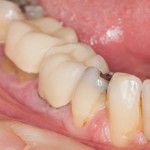
Coronal seal is known to be a major key component for successful restoration of the endodontically treated tooth. The type of restoration conventionally used is either an indirect restoration of the tooth using a single crown or a direct restoration with a filling material such as composite. Shu et al 2018, demonstrated a weak recommendation for indirect restorations to restore endodontically treated teeth, especially for teeth with extensive coronal damage. The constant aim for improved conservative dentistry and the emergence of CAD/CAM dentistry (computer-aided design and computer-aided manufacturing) helped to increase popularity of adhesive endodontic crowns also called endocrowns. These restorations are defined as a monoblock restoration that uses the pulp chamber and remaining coronal tooth structure as a means of retention.
The aim of this review was to assess whether endocrowns are an appropriate restorative option with a predictable outcome for extensively damaged endodontically treated teeth.
Methods
Searches were conducted in the PubMed (Medline), Scopus, Embase, the Cochrane library and Google Scholar databases. Clinical and in-vitro studies published in the English language comparing endocrowns to conventional crowns were considered. Two reviewers independently selected studies, abstracted data and assessed study quality. The Newcastle-Ottawa Scale (NOS) was used to assess quality. In-vitro studies were assessed separately. Meta-analysis of endocrown and conventional crown survival and success rates was conducted using a random effects model and presented as risk ratios (RR) and 95% confidence intervals.
Results
- 10 studies (3 clinical, 7 in-vitro) were included
- Two of the 3 clinical studies were prospective observational longitudinal studies. The other one was prospective. The average follow-up period was 85 ±10 months.
- In-vitro studies compared the fracture strengths and catastrophic failure rates of endocrowns and conventional crowns: 1 in incisors, 4 in premolars and 2 in molars.
- The fracture strength of endocrowns was either similar or higher than that of conventional crowns.
- The overall rate of catastrophic failures of endocrowns and conventional crowns restoring molars was less than for the same restorations restoring anterior teeth or premolars.
- Clinical studies estimated 5-year survival rates and 5-years success rates for both molars and premolars ( table 1).
- Meta-analysis shows no significant difference in survival rates and success rates between endocrown restorations and conventional crown restorations (table 2).
Table 1: Clinical studies results comparing 5-year survival and success rates
| Survival rates | Success rates | |||
| Endocrowns | Conventional Crowns | Endocrowns | Conventional Crowns | |
| Premolars | 74.4% | 97% | 93.8% | 98.4% |
| Molars | 80.9% | 91% | 89.1% | 98.2% |
Table 2: Meta-analysis for overall survival and success rates of endocrown and conventional crown restorations
| Risk Ratio (95% CI) | |
| Survival rate | 0.92 [0.83, 1.02] |
| Success rate | 0.91 [0.77, 1.08] |
Conclusions
The authors concluded:-
There remains a need for large, well designed, clinically controlled studies with long-term assessment. However, endocrowns appear to be a promising, conservative, and inexpensive restorative option with acceptable long-term survival for endodontically treated posterior teeth in selected patients using standardized clinical procedures.
Comments
Previouslwe looked at another review of endocrowns (Dental Elf – 5th Sep 2016) which suggested that endocrowns may perform similarly or better than the conventional treatments although there were concerned about the limited number of clinical studies.
For this new review the authors have searched 5 major databases and aimed to follow the PRISMA guideline for reporting systematic reviews. The 3 clinical studies reviewed included 226 patients where 123 endocrowns were compared to 99 conventional crowns in total. Despite the lack of clinical randomised controlled studies to be included, this well conducted review and meta-analysis favours the need for further research to support endocrowns as efficient restorations for posterior endodontically treated teeth. Failure of such restorations in the reviewed clinical studies were mainly related to the adhesion process which is usually more demanding (strict moisture control, timing… etc.) and operator-dependant compared to cementation protocols for conventional crowns. Therefore, endocrowns could be a promising restorative option providing there is confirmatory evidence from further high-quality clinical studies.
Links
Primary reference
Al-Dabbagh RA. Survival and success of endocrowns: A systematic review and meta-analysis [published online ahead of print, 2020 Mar 17]. J Prosthet Dent. 2020;S0022-3913(20)30079-2. doi:10.1016/j.prosdent.2020.01.011
Other References
Shu X, Mai QQ, Blatz M, Price R, Wang XD, Zhao K. Direct and Indirect Restorations for Endodontically Treated Teeth: A Systematic Review and Meta-analysis, IAAD 2017 Consensus Conference Paper. J Adhes Dent. 2018;20(3):183‐194. doi:10.3290/j.jad.a40762
Dental Elf – 5th Sep 2016
